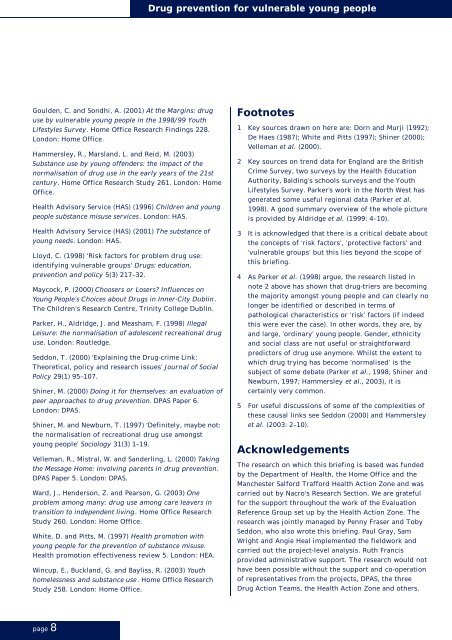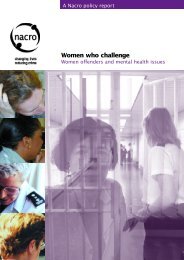Drug prevention for vulnerable young people - Nacro
Drug prevention for vulnerable young people - Nacro
Drug prevention for vulnerable young people - Nacro
You also want an ePaper? Increase the reach of your titles
YUMPU automatically turns print PDFs into web optimized ePapers that Google loves.
<strong>Drug</strong> <strong>prevention</strong> <strong>for</strong> <strong>vulnerable</strong> <strong>young</strong> <strong>people</strong>Goulden, C. and Sondhi, A. (2001) At the Margins: druguse by <strong>vulnerable</strong> <strong>young</strong> <strong>people</strong> in the 1998/99 YouthLifestyles Survey. Home Office Research Findings 228.London: Home Office.Hammersley, R., Marsland, L. and Reid, M. (2003)Substance use by <strong>young</strong> offenders: the impact of thenormalisation of drug use in the early years of the 21stcentury. Home Office Research Study 261. London: HomeOffice.Health Advisory Service (HAS) (1996) Children and <strong>young</strong><strong>people</strong> substance misuse services. London: HAS.Health Advisory Service (HAS) (2001) The substance of<strong>young</strong> needs. London: HAS.Lloyd, C. (1998) 'Risk factors <strong>for</strong> problem drug use:identifying <strong>vulnerable</strong> groups' <strong>Drug</strong>s: education,<strong>prevention</strong> and policy 5(3) 217–32.Maycock, P. (2000) Choosers or Losers? Influences onYoung People’s Choices about <strong>Drug</strong>s in Inner-City Dublin.The Children’s Research Centre, Trinity College Dublin.Parker, H., Aldridge, J. and Measham, F. (1998) IllegalLeisure: the normalisation of adolescent recreational druguse. London: Routledge.Seddon, T. (2000) ‘Explaining the <strong>Drug</strong>-crime Link:Theoretical, policy and research issues’ Journal of SocialPolicy 29(1) 95–107.Shiner, M. (2000) Doing it <strong>for</strong> themselves: an evaluation ofpeer approaches to drug <strong>prevention</strong>. DPAS Paper 6.London: DPAS.Shiner, M. and Newburn, T. (1997) ‘Definitely, maybe not:the normalisation of recreational drug use amongst<strong>young</strong> <strong>people</strong>’ Sociology 31(3) 1–19.Velleman, R., Mistral, W. and Sanderling, L. (2000) Takingthe Message Home: involving parents in drug <strong>prevention</strong>.DPAS Paper 5. London: DPAS.Ward, J., Henderson, Z. and Pearson, G. (2003) Oneproblem among many: drug use among care leavers intransition to independent living. Home Office ResearchStudy 260. London: Home Office.White, D. and Pitts, M. (1997) Health promotion with<strong>young</strong> <strong>people</strong> <strong>for</strong> the <strong>prevention</strong> of substance misuse.Health promotion effectiveness review 5. London: HEA.Wincup, E., Buckland, G. and Bayliss, R. (2003) Youthhomelessness and substance use. Home Office ResearchStudy 258. London: Home Office.Footnotes1 Key sources drawn on here are: Dorn and Murji (1992);De Haes (1987); White and Pitts (1997); Shiner (2000);Velleman et al. (2000).2 Key sources on trend data <strong>for</strong> England are the BritishCrime Survey, two surveys by the Health EducationAuthority, Balding’s schools surveys and the YouthLifestyles Survey. Parker’s work in the North West hasgenerated some useful regional data (Parker et al.1998). A good summary overview of the whole pictureis provided by Aldridge et al. (1999: 4–10).3 It is acknowledged that there is a critical debate aboutthe concepts of ‘risk factors’, ‘protective factors’ and‘<strong>vulnerable</strong> groups’ but this lies beyond the scope ofthis briefing.4 As Parker et al. (1998) argue, the research listed innote 2 above has shown that drug-triers are becomingthe majority amongst <strong>young</strong> <strong>people</strong> and can clearly nolonger be identified or described in terms ofpathological characteristics or ‘risk’ factors (if indeedthis were ever the case). In other words, they are, byand large, ‘ordinary’ <strong>young</strong> <strong>people</strong>. Gender, ethnicityand social class are not useful or straight<strong>for</strong>wardpredictors of drug use anymore. Whilst the extent towhich drug trying has become ‘normalised’ is thesubject of some debate (Parker et al., 1998; Shiner andNewburn, 1997; Hammersley et al., 2003), it iscertainly very common.5 For useful discussions of some of the complexities ofthese causal links see Seddon (2000) and Hammersleyet al. (2003: 2–10).AcknowledgementsThe research on which this briefing is based was fundedby the Department of Health, the Home Office and theManchester Sal<strong>for</strong>d Traf<strong>for</strong>d Health Action Zone and wascarried out by <strong>Nacro</strong>'s Research Section. We are grateful<strong>for</strong> the support throughout the work of the EvaluationReference Group set up by the Health Action Zone. Theresearch was jointly managed by Penny Fraser and TobySeddon, who also wrote this briefing. Paul Gray, SamWright and Angie Heal implemented the fieldwork andcarried out the project-level analysis. Ruth Francisprovided administrative support. The research would nothave been possible without the support and co-operationof representatives from the projects, DPAS, the three<strong>Drug</strong> Action Teams, the Health Action Zone and others.page 8
















